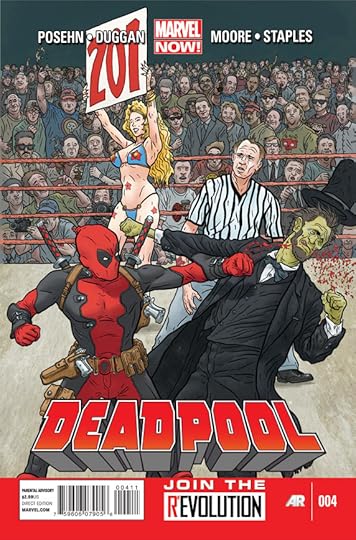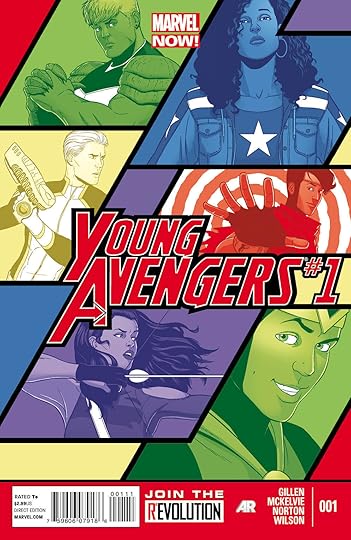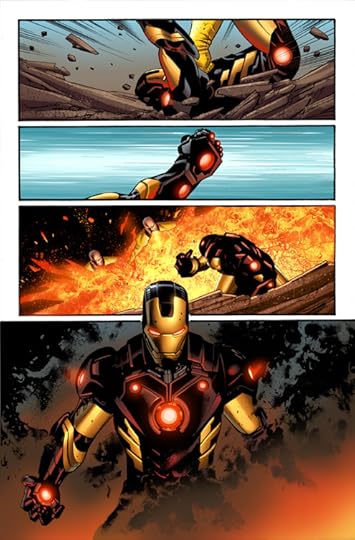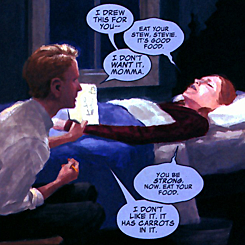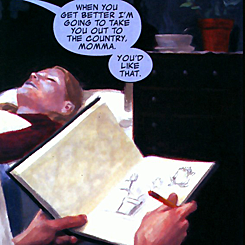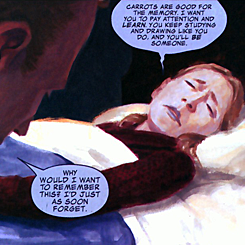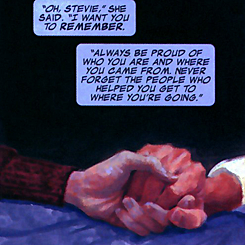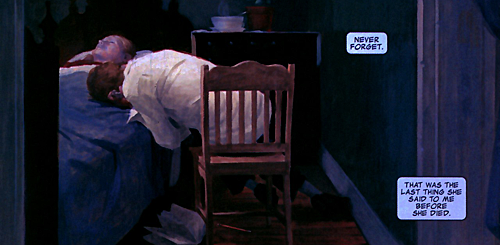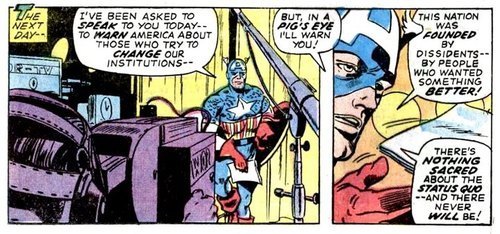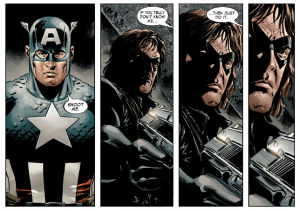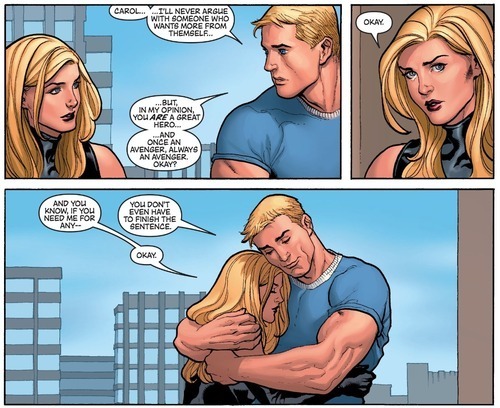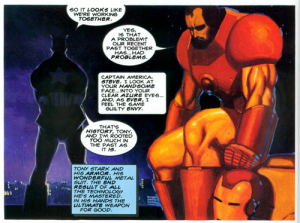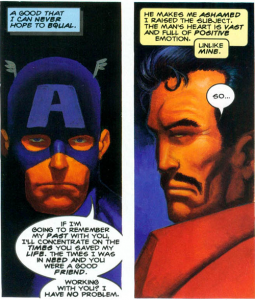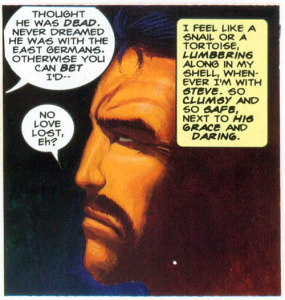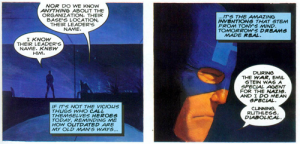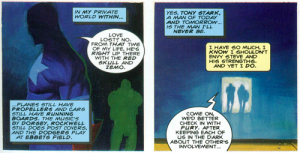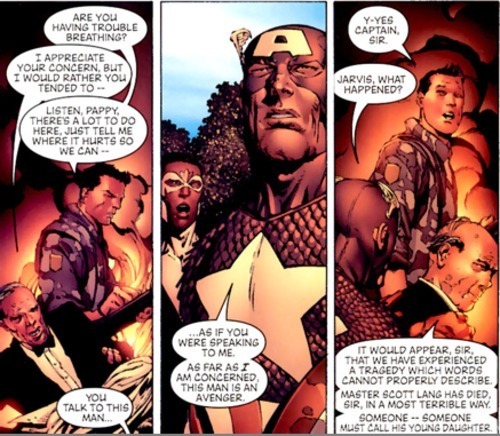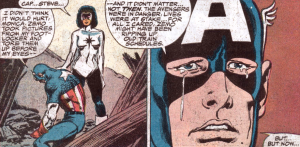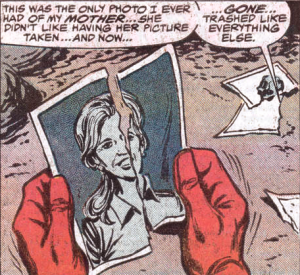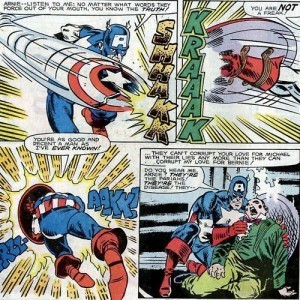Magen Cubed's Blog, page 28
January 24, 2013
Comic book review: Deadpool #4
It’s a cage-match to the death between Deadpool and Abraham Lincoln in this month’s installment. Written by Brian Posehn and Gerry Duggan with art by Tony Moore.
After disposing of JFK (dressed as Marilyn Monroe, no less), Deadpool gets his order to re-kill some D-list presidents causing trouble at the Golden Gate Bridge. He and the ghost of Benjamin Franklin drop in on a rally in support of the reanimated leaders to gut the slew of them in various skillful and gruesome ways. Right after some jokes and fourth-wall breaking, it’s off to the Hoover Dam to stop Herbert Hoover and Co. from blowing it up. More violence follows before Deadpool goes to a nuclear power planet to keep Lincoln and an assortment of Adamses from wiping San Onofre off the map. He manages to put-down various presidents before Lincoln makes an escape via helicopter, which Deadpool is able to trace by throwing his cellphone onboard at takeoff.
Meanwhile, Agent Preston learns that the necromancer Michael and another agent named Gorman were part of Nick Fury’s secret psi-weapons program. Tracking the phone, S.H.I.E.L.D. follows Lincoln to Vegas as he crashes a UFC fight. As Preston orders the building’s evacuation Deadpool distracts Lincoln by challenging him to a cage-match, with the added bonus of some commentary from Lincoln on Deadpool’s commercial oversaturation. In the end Deadpool chops Lincoln’s head off with a katana and all’s well that ends well.
What can I say about this book that I haven’t already said? If you’re looking for a straightforward, gory read, Deadpool delivers exactly what it promises. Lots of blood and guts mixed with flimsy one-liners and consistently good artwork by Moore, this issue is just more of the same. I tried to have an open mind about this title, but the jokey, one-note dialogue is more grating than funny, and the whole thing falls flat for me. Maybe this works for some readers, but I just can’t get behind this title.
Comic book review: FF #3
John Storm comes back from the future with a message and a mission in the third issue of this fun, kitschy title. From Matt Fraction and Mike Allred.
Battle-scarred and aided by cybernetic prosthetics, a much older Johnny Storm sits on the couch at the Future Foundation, telling his story to the FF. In the future the rest of the Fantastic Four dies beyond the veil of space, and Doctor Doom, Kang the Conquer and an Annihilus Kang join forces (and bodies) to take advantage of their enemies’ deaths. Running away from Doom the Annihilating Conqueror (what else would you call this guy?) for years, this Johnny came to the current timeline to close the portal and keep Doom bay. Johnny wants to enlist the FF to help him destroy Doom, but unprepared for cosmic battle and still dealing with problems of their own, Ant-Man and company aren’t ready to run off into space just yet.
Meanwhile, Moleman is meeting with the Moloids. It turns out they hired him to cause trouble, in order for the FF to come together, in exchange for a starheart. Darla tries to go back on tour and forget about the FF, still feeling like a coward for leaving. Shrinking down to sneak into Darla’s hotel room, Scott delivers a note to try to persuade her to come back, but when the Yancy Street Gang delivers a whipped cream bomb the touching moment backfires as Scott sizes up to try to save Darla. Covered in sticky-stuff (and with Darla in a bath towel), three gang members wearing Thing masks burst in to take embarrassing photos of them before taking off. Chasing after the gang, Darla (still in a towel) and Scott end up in the middle of Times Square on New Year’s Eve, where they lose the three men in the crowd. With the Yancy Street problem forgotten for now, Scott tells Darla about what happened to the Fantastic Four. He convinces her to come back with him to find Doom, and eradicate him before he can kill the Fantastic Four.
Fraction delivers another fun romp into this world, with equal measures of weirdness and heart. There are a lot of nice little moments here, grounding the team’s uncertainty as Scott continues to deal with the death of his daughter Cassie. There’s a sense of mourning in this issue, as the FF try to comprehend John Storm’s story and put their reservations on the backburner in order to keep it from happening. As always Allred’s pencils walk the line between the weird and the heroic with ease, crafting a story that has both humor and subtly. As the plot picks up steam, I’m looking forward to what’s around the corner.
Comic book review: Uncanny Avengers #3
Red Skull calls on his fellow man to eradicate mutantkind, as Captain America assembles a new team to fight back against the Eternal Reich, in this third installment of Uncanny Avengers. From Rick Remender and John Cassaday.
Using Xavier’s stolen brain, Skull goes before the people of New York City with a call to arms against the mutant threat. He assembles his S-Men (who are not mutants as previously presumed, but humans enhanced through genetic experimentation and occultism) to present a brainwashed Scarlet Witch and Rogue to the masses, declaring war on mankind. Skull’s psychic broadcast spreads all over the city, erupting in violence as humans and the S-Men begin murdering mutants in the streets. Led by Captain America and Havok, the Avengers arrive on the scene in what becomes all-out war.
Splitting up to take on Red Skull’s forces across the city, we see each Avenger test their mettle in this fight. Captain America struggles against the brainwashing while Havok, still asserting himself as the leader of this group, knocks some sense into him before he can do any real damage. Wolverine is overcome by one of the S-Men’s toxins before Scarlet Witch and Rogue step in, and Thor is swept up by psychic propaganda and led to Skull’s side. As Wolverine attacks Skull, slicing off his hand, Thor retaliates. He incapacitates Wolverine for Skull, and taking him with them as they retreat from battle, leaving destruction in their wake. With a god now serving the Eternal Reich, all seems hopeless as the book closes on Skull’s apparent victory over the Avengers.
Remender delivers another solid issue, the non-stop action balanced by clever choices in character insights and storytelling. We get a clear sense of the horror going on as mutants die bloody in the streets, their personal stories and tragic last moments expanded on for the reader, grounding the theatrics and the drama in something tangible. As with previous issues Remender does a great job with shifting the focus from character to character, showing every side of the fight in fair and evenhanded measures. It keeps the story compelling without bogging things down with unnecessary exposition, and shows the dysfunctions in this team as they try to rise to the challenges ahead of them. Although some of the language in the captions is a little theatrical for my tastes, I’m really enjoying the writing.
Cassaday’s pencils are strong here and move things along well, full of great detail and a lot of drama that never slows down as the narration shifts throughout the story. I still have nitpicks with his rendering of Cap’s uniform (the super-pronounced scales kind of drive me nuts), and some facial inconsistencies panel-to-panel, but overall the art is solid. Also, so many props to colorist Laura Martin for bringing Skull’s psychic onslaught to life.
While I had some reservations in the beginning, this book is shaping nicely as a fresh action title with a clever threat and an interesting hook.
January 23, 2013
Comic book review: Young Avengers #1
From Kieron Gillen and Jamie McKelvie with Mike Norton, this is not the Young Avengers we all remember.
This is a different team, a different story, and a different part of their lives. This is about being an adult, which we quickly learn as Kate Bishop wakes up in Noh-Varr’s bed one morning, admiring the Earth from his ship far above it. She’s not the Kate we know from Matt Fraction’s Hawkeye. That’s another Kate for another day, because at this moment, this is everything she’s ever wanted: Watching Noh-Varr dance to 1960s music and talk about the philosophies of his home dimension. Until, of course, the Skrulls attack. What begins as a life-affirming moment in the strange bed of a beautiful boy ends in chaos as Skrull descend upon Noh-Varr’s ship. Kate is powerless and unprepared, especially compared to Noh-Varr who quickly dispenses a Skrull through his bedroom window, but it’s all systems go from there as she jumps into the cockpit and races out of the line of fire. She is, after all, a superhero. Meanwhile, in New York, life is far quieter for what remains of the Young Avengers.
Teddy is, more or less, on a quick errand. Ambushing some thugs about to rob a woman at gun-point, he takes Spider-Man’s form to beat them up before fleeing as the cops arrive. He goes home to Billy and his parents, sneaking in through the bedroom window and getting caught in the act. Having been discovered by one of the neighbors and their cellphone camera, the jig is up, and Billy is not happy. He wants for them to hang up the superheroics, having buried too many friends since becoming Avengers. Teddy, still dealing with his mother’s death, is tired of hiding what they are, and having to console Billy despite his own pain. They make up after their fight, and Billy agrees to come out of his self-imposed retirement and honor Teddy’s wishes. What he doesn’t tell Teddy is that he’s using his powers to search through all possible worlds in order to bring Teddy’s mother back. That would just complicate things.
Nearby, Loki is enjoying a milkshake at a greasy diner, and trying to convince the waiter that him not paying his tab his completely true to his character. When he senses Billy’s plan, Loki teleports to the roof of Billy’s apartment to stop him, only to have Miss America drop in as well. Still looking to pummel Loki after their last encounter, America and Loki scuffle, waking Teddy who runs out to stop them. Meanwhile, Billy, unaware, is browsing through the dimensions and pulling Billy’s mother into their time. Knowing this, Loki casts a spell. Caught in the act by Teddy, Loki teleports away and Miss America flies off, and returning downstairs Teddy is reunited with his mother. What should be, by all accounts, a happy ending, closes on a bit of a downer as Teddy’s mother turns out to be not quite what she seems, consuming Billy’s parents and liquefying them at the kitchen table.
I’m going to be honest: I unabashedly loved this book. Gillen’s writing is well-rounded and poignant, with each of these characters coming from an organic and fully realized place. McKelvie’s and Norton’s artwork is slick, engaging and a joy to see, the design work energetic and well-complemented by Matthew Wilson’s colors. Most of all, the theme of dealing with adulthood resonates so well throughout. This is a book is about the most pressing question most of us face when we turn 18: Now what? It’s about people making choices, facing consequences, and learning from the past, even when they stumble — because they will stumble. It makes for a compelling story, moved by action but balanced by a real sense of heart. On my second and third read of this issue, I still have no real complaints, and that hardly ever happens.
That said, this title may not jive with everyone. The panel formatting and some of the storytelling is very stylized, and unless you know these characters already you may not be able to jump in quickly. Casual readers may be a bit lost, especially with Miss America’s beef with Loki, which is kind of the opposite of most other titles under the Marvel NOW umbrella. For me, however, this issue is just joyous, and I can’t wait for more.
January 21, 2013
Full disclosure: A deeper look at Iron Man from Marvel NOW
Now that the first arc of Kieron Gillen’s current run of Marvel NOW’s Iron Man is complete, I’d like to take a moment to discuss that. As I did with Captain Marvel into the first few issues of its current run, sometimes it’s nice to slow down and really dig into a title. When you review month-to-month, and sometimes bimonthly in this case, it can be difficult to really step back and judge a series on its merits and intentions, strengths and weaknesses. With a title like this one, which has received its fair share of criticism so far, it can be equally difficult to be objective when your little fangirl heart is weighed down by expectation, and you fear your reviews might be getting colored by all the Greg Land jokes. So setting all of that aside, let’s talk about Tony Stark.
Let me start off by saying this about Kieron Gillen: I love him. I wasn’t all that familiar with his work before this summer, when my girlfriend Melissa carefully explained Phonogram in loving and painstaking detail. After this, excited to see the books he was writing for Marvel NOW, I began doing what I always do with writers I’m interested in: I went to the internet and stalked him like a wounded gazelle. And you know what? I love this guy. From Twitter to Tumblr, from blog posts to interviews, I find myself endlessly entertained and excited by his world and his work. But it’s not just his writing that draws me in, but the way he talks about writing. This is a guy who truly cares about the characters he writes, and crafts these wonderful little posts and statements of intent about what he wants to do with them, like they’re real people sitting around in his living room having coffee. As a writer, that is so fascinating, and while it sounds like I’m just congratulating Gillen on his continued existence, this has everything to do with Iron Man for me as a reader.
This book hit the shelves with a lot of big promises: It would be the thinking man’s Iron Man. It would be a more human, in-depth portrait of Tony Stark. It would discuss things that most writers never touch. Of course, coming right off Matt Fraction’s legendary (and I don’t throw that word around lightly, by the way) run, it’s hard for anybody to match up. Keep in mind that Fraction and Gillen are telling two entirely different stories, about two different ways of looking at Tony Stark. I loved Fraction’s Tony, for all the ways he’s pulled apart and reassembled this character in satisfying and interesting reinterpretations. To me, Fraction’s Tony always seemed more emboldened, more assured, more in control, even when he wasn’t. Gillen’s Tony, however, is at a crossroads. Yes, this Tony is charming. I’m hard-pressed to find a fan who doesn’t find Tony Stark charming to one degree or another, even if it is just a front and he’s a total existential mess inside. This just comes with the territory. But this Tony is, as we’ve seen so far, working on himself.
Only five issues in, and we see this Tony taking inventory. He’s contemplative. He’s unsure of what he’s doing. He’s building new suits and new AIs and trying to sort himself out. He’s faced with death and disillusionment, and he’s dealing with it by hanging out in his workshop and explaining his philosophy on grilled cheese sandwiches to Pepper. To me, this is a Tony in the middle of a journey even he’s not too sure about. Carrying that theme, there are a lot of good moments in this book that shed a little light on how Tony operates. Issue four, for example, deals with Tony’s relationships with women. Just after being chastised by Pepper for viewing all women as objects, unable to tell them apart but for their hair colors, Tony is faced with a horde of identical female Extremis enhanciles that he has to put down. (I’m hoping that this was a clever visual metaphor, and not just bad pencils from Greg Land, but I’m going to try to give these guys the benefit of the doubt here.) As a reader, this is one of those things that make me love Gillen’s Tony Stark, and here’s why.
For me, Playboy Tony is my least favorite aspect of Tony Stark’s character. It’s that ghost in his backstory that we can’t seem to get rid of, because we all accept it as vaguely amusing that he has bad relationships and sleeps with everything that moves. Outside of his wonderfully complex relationship with Pepper, in recent years I don’t often see many writers giving Tony much credit in that department, which really over-simplifies the issue. Readers tend to assign negative connotations to the rest of his behavior (the alcoholism, the self-loathing, the father issues, the occasional bout of unchecked megalomania) and consider these things that need to be addressed or remedied in order for him to grow. As fans, we want him to stay sober and to not hate himself, but we’re still content to see him bury his problems in nameless, faceless women (often portrayed as stupid or vapid) we know he doesn’t care about and won’t remember in the morning. We accept his addiction to alcohol as a problem, but not his potential addiction to sex.
This really bugs me, because I know that Tony Stark could get any girl that he wants. He’s Iron Man, he’s a billionaire, he’s a genius — I get it. But what I’m far more interested in seeing is a Tony who can get any woman, anywhere, anytime, and chooses not to. Maybe he just, you know, wants to go home and read a book? Catch up on Grey’s Anatomy? Sex is a powerful tool at a writer’s disposal, and I tend to think that in the case of Iron Man, it hasn’t always been used to its fullest potential. Yes, Gillen’s Tony is still a playboy, but at least now he’s thinking about his decisions and trying to better understand them. I happen to like that a lot.
(As an aside, the scene in the bar in issue one, where we see the blonde is playing Tony as much as he’s playing her? So good.)
Small moments like these carry a lot of weight in this book, as Tony learns a little every issue, and we see him grow just that tiny bit more. Without the more real-life consequences of rehab, or AA, or even the threat of imprisonment looming overhead to spur Tony’s personal change, the book relies on these scenes. It’s subtle, but it’s there. This is Tony Stark, slowly but surely, moving toward self-realization. Which brings me, inevitably, to the ultimate drawback of this book so far: The format.
Now, I do appreciate what Gillen’s doing. As a writer, I get it, and I kind of think it’s awesome. It’s a throwback to the classic comic and cartoon serial: Self-contained episodic adventures, leading the character to a series of objective-based conclusions, and throwing out clues to a larger story in the future. The problem I have, however, is that it feels misplaced here. In five issues, we’ve barely scratched the surface of this book’s long-term goals, and are instead left with a somewhat disjointed series of events with a vague theme of self-discovery. As a fan, I’m disappointed, but as a writer, I get it, and understand the decisions that drove this format in the first place.
As we all know, this title is being written in the wake of the Marvel Cinematic Universe. This isn’t for guys like you and me, who have known and loved this character for years. It’s for new fans, and casual fans, who came to know this character through Robert Downey, Jr.’s Tony Stark and Joss Whedon’s Avengers. Marvel wants a stream-lined and accessible title for these potential new readers, because, well — Iron Man is huge right now. He’s on t-shirts and lunchboxes and backpacks, and in at least three cartoons that I’m immediately aware of. Iron Man is a cash-cow, and The Powers That Be want to keep him easy to understand. I get that. That’s what Marvel NOW is all about. I’m just not sold that this format is the correct way to go, as I see this model being applied with more success in other titles.
Rick Remender’s Captain America, for example, is another title I’m reading from the re-branding. The same character with his own film series and action figure line has been radically altered from what casual fans know of the MCU. This is a fairly apocalyptic book, where Steve Rogers is transported to Dimension Z and forced to survive by his wits and resolve alone. He spends a year raising a rescued boy he’s named Ian and struggling to keep them alive in the face of ever-present danger and almost certain death. This book is harsh and personal and quietly compelling, and flies in the face of “safe,” “easy” storytelling. In the wake of the MCU, and this influx of new fans, I find it interesting that these are the stories about Captain America that are being told. This very personal narrative style is also going on in two other books I’m really enjoying right now, Hawkeye from Matt Fraction and Captain Marvel from Kelly Sue DeConnick. Even as they operate under the Marvel NOW umbrella, these books mostly rely on the episodic arc that Iron Man is drawing from, while still retaining their own sense of continuity and thematic sensibility.
In Iron Man, we’re still lacking that sense of cohesion, and to larger, potentially more damaging extent, that sense of readership loyalty. Fans are accustomed to a certain level of emotional subtext and personal continuity within their favorite stories, whether in characterization or overarching tone. Obviously there are going to be differences between this iteration of Iron Man and its predecessors, but in this rush to make Iron Man safe and accessible, it seems some heart got lost along the way. Yes, Gillen’s Iron Man focuses on smaller snapshots in the life of Tony Stark, as he solves puzzles and goes on adventures and tries to work on himself as a human being. Even for it, the book almost feels sanitized, taken out of the context of the larger Marvel pantheon and existing in a strange vacuum. Almost all solo titles operate in a vacuum to one degree or another, but this Iron Man feels very far removed from everything else that we know of the character and his history. So often it’s just him, Pepper, and the Villain of the Week, bang bang bang, action and adventure, then it wraps up with a nice moral lesson and Tony jets off to the next issue. It’s so small, it’s microscopic, and as readers we want things to be a little more macroscopic. Is there a place in the middle where these two can meet? I hope so.
All of this said, taking the mountains of Greg Land jokes aside, I do actually enjoy this series. I do love these pow-wow scenes between Tony and Pepper, where Tony contritely explains why he does the strange, stupid, and too-often hurtful things that he does, and promises to do better. I do love Tony’s narration in battle, putting a personal context to his life as a superhero. I do love that Tony makes grilled cheese in the workshop, and wants to go into space, and wants to do right by Maya’s memory, even if he has to do ugly things to get it done. I do love this second, confusing, middle-aged puberty Tony’s going through, because if anybody can steer him toward an interesting personal journey, it’s Kieron Gillen. There are so many things I truly love about this book, and about Gillen’s plans for Iron Man, and the disappointments feel almost crushing in comparison. I am of two minds about this Iron Man, as a writer and a reader. Do I recommend the book? No, because I have issues with the format, but also yes, because I’m so fascinated to see what might happen next. This is a book that needs to find sure footing, and by moving into the next arc, and expanding on the larger context of the Marvel Universe around Tony, it hopefully will.
In the end, I just have to accept that I have a love/hate relationship with this book, just as I do with the character himself. Some days I love Tony Stark, others I throw the book across the room and scream. But, hey — that’s what being a fan is all about, right?
January 17, 2013
Comic book review: New Avengers #2
The Illuminati descend upon Wakanda to stop the end of the world in the latest issue from this reality-spanning title. From Jonathan Hickman and Steve Epting.
Time is fluid in Hickman’s world. Three hours earlier at the Necropolis in Wakanda, Reed Richards is interrogating the Black Swan, the captured alien invader, and analyzing the destructive device inside of her. She and her army destroyed Earth in the reality they came from, and she warns Reed that his people are completely unprepared for the hell that is coming. An hour ago, Black Panther visits with Namor, much to the trepidation of T’Challa’s guards. He warns Namor to behave himself in Wakanda, and to go unseen and unheard as not to anger its wary people, recalling the fallout of Avengers vs. X-Men. Namor is unfazed by T’Challa’s forewarning, and as they leave to meet with the rest of the Illuminati, T’Challa swears to kill him once their business is done.
At their gathering, the many egos of the group clash over their next move. Reed gives his ominous speech from the first issue in a scene moving forward in real-time and provides some much-needed exposition on the Multiverse. We learn that all of the infinite timelines, no matter how disparate, will eventually all arrive in the same place and state. In one of the parallel universes, on a parallel Earth, an event occurred so devastating it obliterated the entire timeline, causing a ripple affect across the Multiverse. Now everything is going to die, but much sooner, as these ripples cause timelines – and Earths – to collide.
If one Earth is destroyed, it eliminates the incursion point, allowing the other will survive and stopping the pan-reality catastrophe. With only an eight-hour window at the point of collision to act, the council faces universal annihilation if they don’t help the Black Swan destroy the other Earth and save their timeline. Resolving to find the late Charles Xavier’s lost Mind Gem, they set about to reassemble the Infinity Gauntlet and do the unthinkable: The Illuminati are going to destroy a world. The issue ends on a brief flash-forward, narrated by Captain America’s inspired call to battle, showing the horrors that lie ahead in a chilling contrast.
Ominous and somber, this was the book I expected in the first issue, and it did not disappoint. The liquid flow of time emphasizes the colossal danger ahead as T’Challa, Reed and the others struggle with each other and themselves to make the right decision. All the characters are better established here than in the last issue, and Hickman’s treatment of each is very satisfying. Their dissimilar personalities and histories are explored in brief but tantalizing scenes, showing the various brands of arrogance each of them bring to the table, while the plot remains well-grounded through T’Challa’s story. The grim tone and pace was well-implemented by Epting’s cinematic style, although with most of the book taking place at a round-table discussion, it gave Epting little room to really stretch his creative legs. That said, his work is highly effective and complements Hickman’s story perfectly.
With only a few nitpicks here or there to take away from a very promising arc, this Avengers book is a completely different animal its sister titles, and I’m looking forward to seeing how far these men go to achieve their goals.
Comic book review: Captain Marvel #9
It’s just another day for Captain Marvel as Carol goes about a busy afternoon in New York City – until, as usual, disaster strikes. From Kelly Sue DeConnick and Filipe Andrade.
The day starts off on the wrong foot Tony Stark hacks Carol’s phone (as well as her calendar) for his own amusement and/or personal gain, making Carol’s pounding headache even worse. He calls in a favor for a friend, in need of a pilot to deliver food and medicine to disaster zones, and volunteers Carol for the job. Carol, of course, is not thrilled. Agreeing anyway, she soon sets about her day by first taking her cat Chewie to the vet. We see Carol going about her normal routines: Getting coffee from a food truck for her date with Jessica Drew, and visiting with Rose, an elderly woman who feeds the pigeons at the park. When two dinosaurs attack Manhattan, Captain Marvel and Spider-Woman cancel their plans to provide a good old fashioned beat-down before sending the misplaced beasts to Reed Richard’s door. (You know, for research purposes.)
Her plans mostly ruined, and her schedule completely turned upside-down, Carol’s meeting with Tony’s contact Michael Air immediately goes sideways. Held up at gunpoint by armed thugs, it turns out Michael Air is the name of a non-profit group run by Frank Gianelli, who we meet in issues #7 and #8, and is currently being held hostage. After another beat-down, Carol agrees to help Frank, and then jets off to her doctor’s appointment. With all her friends holed up in the waiting room outside, Carol and Chewie sit down with her doctor for some bad news. The issue closes on the bombshell that not only does Carol have a lesion in her brain, she can no longer fly.
Full of action and wit, this is another charmer of an issue from DeConnick that ends in a cliffhanger I didn’t see coming. Serving as the starting off point for new readers, as well as a new arc, I loved seeing all of Carol’s friends here, each of them coming together as these little facets of her very busy and complicated life. I love everything about this issue, especially art from Filipe Andrade, with colors by my personal favorite Jordie Bellaire. Andrade’s art is unique and whimsical, and his vision of Carol seems lighter than air, about to come off the page at any moment. And how great is Jamie McKelvie’s cover?
Funny, engaging, and personal, I can’t wait to see where this arc takes us.
Comic book review: Captain America #3
We learn the depths of Zola’s depravity, as well as the wealth of Steve Rogers’ resolve, in this third issue chronicling Captain America’s journey into the perilous wasteland of Dimension Z. From Rick Remender and John Romita, Jr.
After the dramatic cliffhanger of last month’s issue, we open on a flashback to Switzerland in 1929, to learn how Armin Zola began experimenting with what he calls “human perfection.” We see him turn away the husband of his maid, Hilda, who has come to ask Zola about his missing wife. Zola brushes the husband off casually before retreating to his laboratory, where he keeps the ghoulish evidence of his pet projects. There he has Hilda in a glass cage, cowering, blood-splattered, her head fixed to the body of her Doberman. This gruesome scene gives way to the present, as Zola prepares his daughter Jet to face a horde of monsters that looms outside, and the “wretched evils” that await them all.
Meanwhile, still in Phrox Cavern, Steve frees himself of his captors to save Ian from execution, breaking his own hand in the process. Badly wounded, he uses Hank Pym’s universal translator to try to reason with the Phrox, convincing them he wasn’t sent by Zola. He and Ian are given shelter by a Phrox named Ksul and his wife. As Ian eats, Steve paints to calm his nerves and distract himself from the pain, trying to think of a way to get back to his own dimension. However, this peace is short-lived as Steve inadvertently causes trouble in the Phrox tribe, and Ksul and the tribal leader Zofjor fight over control of their clan. Ksuk dies in the scuffle as Zofjor turns on the injured Steve, who has to defend himself against the angered warrior with what little strength he has left. After the fight Steve staggers off alone, bleeding and hurt, and learns the true horror of Zola’s experiments as he discovers Zola is watching him from a screen implanted in his chest.
While the pace does move a bit fast for my tastes, I’m really enjoying Remender’s writing so far. We see more scenes from Steve’s childhood here, fighting back against bullies to save his friend Roth in 1930. These little snapshots provide a poignant image of a young Steve Rogers, growing up in poverty and having to take up work as a paperboy to help support him and his mother. Remender lovingly paints Captain America as this dual-natured character: The stoic hero forging his way through this treacherous wasteland in order to save Ian’s life, and the world-weary young man under the mask, shaped by a hard childhood in 1930s New York City, resigned to death. This Captain America is at a crossroads, with the man he has been and the man he could be, if he makes it out of Dimension Z alive. I, for one, think that’s fabulous.
In this issue, however, Romita’s art continues to be a bit of drawback. So many panels lack consistency and detail, and his kids in Steve’s childhood flashback sequence have such cartoonishly large heads that it’s kind of distracting. All art criticism aside, this is another enjoyable issue from what’s shaping to be a fascinating chapter in the life of the Sentinel of Liberty.
January 16, 2013
Why Captain America is my favorite superhero, period
Having lunch and coffee with a very dear friend of mine recently, she and I had a very interesting conversation about — what else? — superheroes. Now, for the record, I’m a staunch Marvel stan since 1993 and she has loyalties on both sides of the comic book aisle, but we can both heartily agree that our love for Captain America is strong, undying, and probably a little creepy. (You see these stars in my eyes? This crying bald eagle reflected in my single perfect tear? I regret nothing.) Over margaritas and vegetarian enchiladas by way of New Mexico, we discussed all things Cap: From his humble beginnings as a World War II propaganda figure, to his current iteration on-screen in the Marvel Cinematic Universe, throwing shade at Robert Downey, Jr. Basically? It was awesome. But more than that, it kind of reminded me why this character is so important to me, not just as an avid comic fan but as a writer. Hell, maybe just as a person.
Before I get into my love for Steve Rogers, I have to preface this by saying that, coming up on comics in the 1990s, I was never a big Cap fan. Yeah, I read a few Avengers issues here and there, and I could appreciate him for all the history, but I was into X-Men. Back then, I liked edgier characters that defied the typical heroic mold. Guys like Deadpool, Pete Wisdom, and Chamber — because you couldn’t get any more alienated than a moody teenager with half of his face blown off. And, let’s be honest: For much of the 90s in X-Men comics, it was like being a party with a bunch of guys trying to see who among them was the grittier asshole. As a kid, I thought that was cool. But growing up a bit, having a calmer head and an ability to better parse out the content I was consuming, I came around to Captain America. And here’s why.
(Let me preface this again by saying that I’m not a comic book historian. I haven’t read every single issue, and I’m well-aware that there have been debates over the years about the various rewrites/retcons of Steve’s backstory. I’m presenting what I know from more recent continuity, so, you know, if you don’t like it I guess you can go find a classic comics blog or something.)
I think that Captain America — when written well — is a fascinating commentary on American culture. For a character that’s often held up on face value to be this All-American, Square-Jawed, White Christian Crusader of All Things Good, he doesn’t do a very good job of it. Steve Rogers is a New Yorker with a liberal arts background, coming up as the frail, sickly child of a poor immigrant family in 1920s and 30s Brooklyn. As a kid he stood by as his physically and emotionally abusive alcoholic father beat his mother, and it was by watching her stand up to him that Steve learned to pull himself up by his bootstraps. 
His mother was the reason he came to stand against bullies wherever he found them, and to always be vigilant in the face of oppression. Yeah, he joined the military because he wanted to do the right thing, and became the iconic soldier he is today. At his heart, however, he’s still that sick kid from Brooklyn: Hiding under kitchen tables, taking beatings from the neighborhood kids because if he starts running, he knows he’ll never stop. He loves art. He draws comics. By nature he creates things rather than destroys them. Isn’t there something a little romantic in that tragedy?
Steve Rogers fights because he has to. He might not always be the hero we think we want, but he’s the right guy at the right time for the job. Sure, he gives all the cowboy speeches and has all of the superhuman abilities, and he makes it all sound big and bright and idealistic. But at the end of the day, his true power comes from being a good man, not a good soldier. All of that said, he’s also been radically anti-government for many periods over the years, which is distinctly unheroic in and of itself. Despite what lackluster writers would have you believe, watching him wave around American flags and make fun of the French, he doesn’t blindly follow orders. He’s cast off the mantle of Captain America many times, as Nomad and The Captain, when his ideals were compromised and he could no longer carry that shield.
That A on his forehead stands for America, but his love for his country is rooted in his hope for its people. It comes from spending the first 20-someodd years of his life watching Americans starve, struggle and bleed in horrifying wars. Because that’s what Steve Rogers cares about above all else: People. Regardless of their race, gender, or anything else, Steve sees the best in people. Everyone is an equal in his eyes, no matter who they are or where they come from, or what they’ve done in the past.
His friendship with Bucky Barnes? C’mon. Heartbreaking.
His long-standing partnership with Sam Wilson? Worthy of its own series.
His epic bromance with Carol Danvers? Perfection.
His lifelong friendship with Tony Stark?
Don’t even start with me, man, I’m going to cry. Hell, Steve’s even there for Jarvis.
While a lot of other heroes take on the Big Picture, in sweeping, operatic storylines that make them out to be the moral authority, Captain America is all about the little things. Yeah, he’s made huge mistakes (the kind that make me rage and throw books across the room), and he’s not a perfect character. Really, he’s a deeply flawed guy, prone to bouts of brooding and self-imposed misery, sometimes getting so hung-up on the job that he loses himself along the way. And, yeah, his love life isn’t always in the best shape, and Steve has a tendency to avoid his relationship problems rather than face them head-on. But, you know what? He’s still a person. He’s still complex. Steve Rogers bleeds, and sometimes he even falls apart. This is not some mindless, Alpha Male character. This is a guy that thinks and feels and above all else, tries. Tries to do the right thing, to be the best that he can for those around him.
People (Read: Spider-Man, but it still counts) refer to him as “the mother” of the Avengers, he’s dealt with body image and self-esteem issues, and he knows what it’s like to feel like you have no control over your own life. As a woman, that rings very true with me, seeing that many of Steve’s personal problems tend to be reserved for archetypal female characters. Watching his mother stand up to his abusive father, Steve grew up to deeply value the women around him, for their strength and heroism as well as their friendship, and to support their journeys. Growing up poor and sickly, Steve knows what it’s like to live in fear of brutality, at the whims of bigger, stronger men. These are attributes that comic book writers and readers would typically assign to a female character, and seeing these traits in Steve is important to me. Is Captain America a feminist character? Maybe? But that’s another post for another day.
And, by the way? His longest, strongest, and most valued relationship has always been with another man, Tony Stark. A man that, when born in an alternate reality as a woman, Captain America married, so take that as you will.
Also, Captain America has taken a firm stance in support of gay rights. So, you know, another point in the Steve Is A Cool Dude column.
To the casual reader/viewer, Captain America looks like a cardboard cut-out conservative symbol for Good Old-Fashioned White American Justice. In reality, one could argue he struggles to represent (as ham-fisted as the delivery may be, since comic book writers aren’t always the most culturally sensitive bunch) everything liberal American culture tries to incorporate in modern society. He wants the best for his country and his friends, regardless of who they are or where they come from, and stands up to tyranny and oppression wherever he finds it. Whether in an alley in 1939, a French battlefield in 1943, or in his own country in 2013, Captain America stands up for all of us.
For a kid from Brooklyn, that’s a hell of a thing.
Now that I’ve gotten a ton of responses from this, here’s some footnotes!
*I really wanted to source all of these scans with relevant information, but…I didn’t scan these, and most of the scan blogs that posted them originally didn’t provide issue/writer/artist information, and then I lost the links to the blogs in order to try to figure out my sourcing, so. That’s incredibly lazy of me, but, you know, I kinda pulled this whole thing out of my ass and stuff for fun. So, um, sorry. I guess.
**Again, not a comic book historian. I haven’t read every issue of everything throughout time and space. And all of this is my interpretation of various canons/timelines/eras/etc. from over the years, some of which conflict and/or have been retconned, and what I’ve taken out of these readings. So, um, sorry if my interpretation of the character differs from yours? Or something.
Why Captain America is my favorite superhero period
Having lunch and coffee with a very dear friend of mine recently, she and I had a very interesting conversation about — what else? — superheroes. Now, for the record, I’m a staunch Marvel stan since 1993 and she has loyalties on both sides of the comic book aisle, but we can both heartily agree that our love for Captain America is strong, undying, and probably a little creepy. (You see these stars in my eyes? This crying bald eagle reflected in my single perfect tear? I regret nothing.) Over margaritas and vegetarian enchiladas by way of New Mexico, we discussed all things Cap: From his humble beginnings as a World War II propaganda figure, to his current iteration on-screen in the Marvel Cinematic Universe, throwing shade at Robert Downey, Jr. Basically? It was awesome. But more than that, it kind of reminded me why this character is so important to me, not just as an avid comic fan but as a writer. Hell, maybe just as a person.
Before I get into my love for Steve Rogers, I have to preface this by saying that, coming up on comics in the 1990s, I was never a big Cap fan. Yeah, I read a few Avengers issues here and there, and I could appreciate him for all the history, but I was into X-Men. Back then, I liked edgier characters that defied the typical heroic mold. Guys like Deadpool, Pete Wisdom, and Chamber — because you couldn’t get any more alienated than a moody teenager with half of his face blown off. And, let’s be honest: For much of the 90s in X-Men comics, it was like being a party with a bunch of guys trying to see who among them was the grittier asshole. As a kid, I thought that was cool. But growing up a bit, having a calmer head and an ability to better parse out the content I was consuming, I came around to Captain America. And here’s why.
(Let me preface this again by saying that I’m not a comic book historian. I haven’t read every single issue, and I’m well-aware that there have been debates over the years about the various rewrites/retcons of Steve’s backstory. I’m presenting what I know from more recent continuity, so, you know, if you don’t like it I guess you can go find a classic comics blog or something.)
I think that Captain America — when written well — is a fascinating commentary on American culture. For a character that’s often held up on face value to be this All-American, Square-Jawed, White Christian Crusader of All Things Good, he doesn’t do a very good job of it. Steve Rogers is a New Yorker with a liberal arts background, coming up as the frail, sickly child of a poor immigrant family in 1920s and 30s Brooklyn. As a kid he stood by as his physically and emotionally abusive alcoholic father beat his mother, and it was by watching her stand up to him that Steve learned to pull himself up by his bootstraps. 
His mother was the reason he came to stand against bullies wherever he found them, and to always be vigilant in the face of oppression. Yeah, he joined the military because he wanted to do the right thing, and became the iconic soldier he is today. At his heart, however, he’s still that sick kid from Brooklyn: Hiding under kitchen tables, taking beatings from the neighborhood kids because if he starts running, he knows he’ll never stop. He loves art. He draws comics. By nature he creates things rather than destroys them. Isn’t there something a little romantic in that tragedy?
Steve Rogers fights because he has to. He might not always be the hero we think we want, but he’s the right guy at the right time for the job. Sure, he gives all the cowboy speeches and has all of the superhuman abilities, and he makes it all sound big and bright and idealistic. But at the end of the day, his true power comes from being a good man, not a good soldier. All of that said, he’s also been radically anti-government for many periods over the years, which is distinctly unheroic in and of itself. Despite what lackluster writers would have you believe, watching him wave around American flags and make fun of the French, he doesn’t blindly follow orders. He’s cast off the mantle of Captain America many times, as Nomad and The Captain, when his ideals were compromised and he could no longer carry that shield.
That A on his forehead stands for America, but his love for his country is rooted in his hope for its people. It comes from spending the first 20-someodd years of his life watching Americans starve, struggle and bleed in horrifying wars. Because that’s what Steve Rogers cares about above all else: People. Regardless of their race, gender, or anything else, Steve sees the best in people. Everyone is an equal in his eyes, no matter who they are or where they come from, or what they’ve done in the past.
His friendship with Bucky Barnes? C’mon. Heartbreaking.
His long-standing partnership with Sam Wilson? Worthy of its own series.
His epic bromance with Carol Danvers? Perfection.
His lifelong friendship with Tony Stark?
Don’t even start with me, man, I’m going to cry. Hell, Steve’s even there for Jarvis.
While a lot of other heroes take on the Big Picture, in sweeping, operatic storylines that make them out to be the moral authority, Captain America is all about the little things. Yeah, he’s made huge mistakes (the kind that make me rage and throw books across the room), and he’s not a perfect character. Really, he’s a deeply flawed guy, prone to bouts of brooding and self-imposed misery, sometimes getting so hung-up on the job that he loses himself along the way. And, yeah, his love life isn’t always in the best shape, and Steve has a tendency to avoid his relationship problems rather than face them head-on. But, you know what? He’s still a person. He’s still complex. Steve Rogers bleeds, and sometimes he even falls apart. This is not some mindless, Alpha Male character. This is a guy that thinks and feels and above all else, tries. Tries to do the right thing, to be the best that he can for those around him.
People (Read: Spider-Man, but it still counts) refer to him as “the mother” of the Avengers, he’s dealt with body image and self-esteem issues, and he knows what it’s like to feel like you have no control over your own life. As a woman, that rings very true with me, seeing that many of Steve’s personal problems tend to be reserved for archetypal female characters. Watching his mother stand up to his abusive father, Steve grew up to deeply value the women around him, for their strength and heroism as well as their friendship, and to support their journeys. Growing up poor and sickly, Steve knows what it’s like to live in fear of brutality, at the whims of bigger, stronger men. These are attributes that comic book writers and readers would typically assign to a female character, and seeing these traits in Steve is important to me. Is Captain America a feminist character? Maybe? But that’s another post for another day.
And, by the way? His longest, strongest, and most valued relationship has always been with another man, Tony Stark. A man that, when born in an alternate reality as a woman, Captain America married, so take that as you will.
Also, Captain America has taken a firm stance in support of gay rights. So, you know, another point in the Steve Is A Cool Dude column.
To the casual reader/viewer, Captain America looks like a cardboard cut-out conservative symbol for Good Old-Fashioned White American Justice. In reality, one could argue he struggles to represent (as ham-fisted as the delivery may be, since comic book writers aren’t always the most culturally sensitive bunch) everything liberal American culture tries to incorporate in modern society. He wants the best for his country and his friends, regardless of who they are or where they come from, and stands up to tyranny and oppression wherever he finds it. Whether in an alley in 1939, a French battlefield in 1943, or in his own country in 2013, Captain America stands up for all of us.
For a kid from Brooklyn, that’s a hell of a thing.

